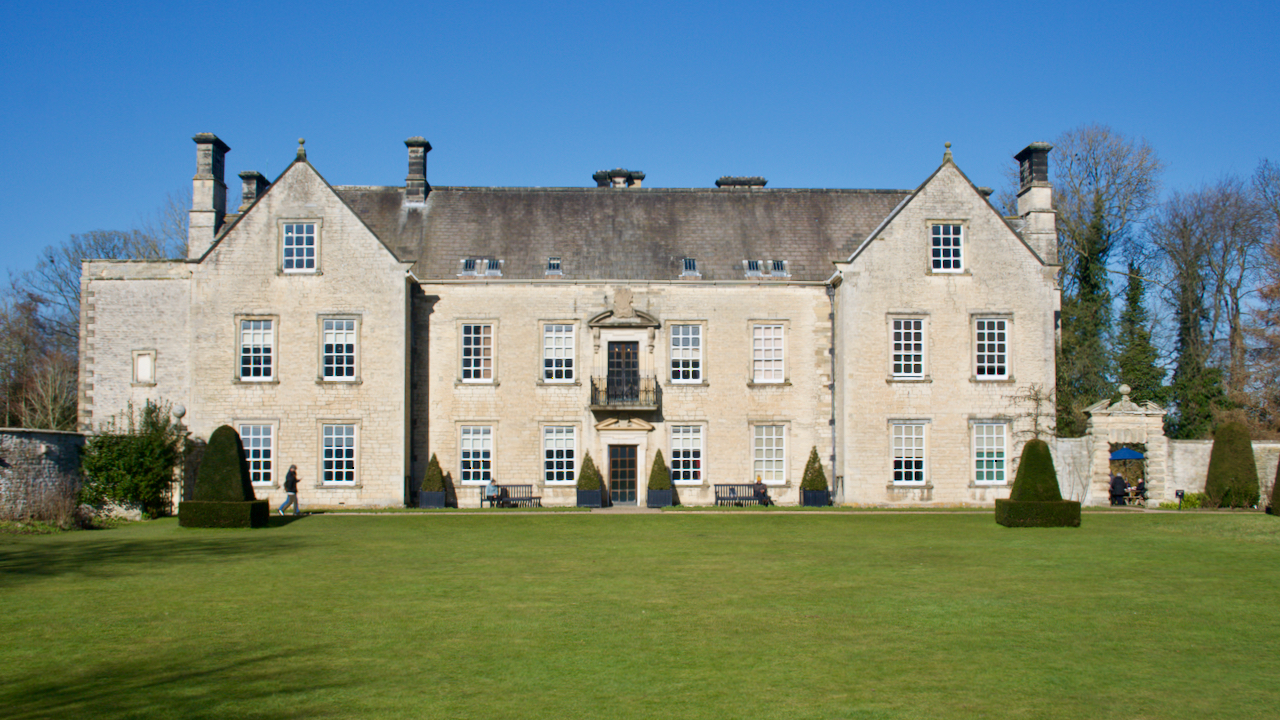This National Trust property is tranquilly situated on the banks of the River Rye. Built on the site of a Saxon homestead it’s a place that oozes history.
The earliest part of the south-facing house dates from the mid-16th-century but most is 17th-century work carried out for Richard Graham, first Viscount Preston and Master of the Wardrobe to James II, who inherited the estate in 16851Pearson, Lynn F. “Building the North Riding”. 1994. Smith Settle Ltd..
In Tudor times, William Parr lived here, so his sister Catharine, the future Queen of England, may well have visited. Come the Civil War the house was used to billet Parliamentary troops and, by the early 19th-century, had declined into a semi-derelict farmhouse.
William Rutson brought the estate in 1839 for £152,388 for use as a sporting lodge and in 1920, his descendant, Margaret Fife transformed the house into a family home, bequeathing the hall to the National Trust in 1952.
A potted history that is informatively displayed in the various exhibitions of the many rooms of the house.
But one chapter seems to have been omitted.
An omission which I think is a missed opportunity.
Enquiries made to the visitor guides as to where the money came from the buy the estate were delicately sidestepped.
Margaret Fife sold her other property, Danby Wiske Hall, to fund renovating the house in the 1920s.
No, before that how did William Rutson get his money to buy it 1839?
He was a merchant from Liverpool.
What did he trade in?
Cotton.
He had links to the slave trade didn’t he?
Oh, we don’t talk about that.
It was so disappointing that the subject, however uncomfortable, was dissimuled.
Perhaps through fear of upset, to avoid controversy, or pressure from certain sections of the media.
But an opportunity missed nevertheless.
William Rutson was the grandson of another William, a cotton merchant and slave trader of Liverpool2Wills, Dr Mary with Dr Madge Dresser, “THE TRANSATLANTIC SLAVE ECONOMY AND ENGLAND’S BUILT ENVIRONMENT: A RESEARCH AUDIT”. Research Report Series no. 247-2020. Page 138. Historic England..
His son, William’s father, was also named William — so we have three generations of Williams. I’ll annotate them grandfather (1), father (2) and son (3).
Between 1780 and 1793, William (1) was a partner in the firm Backhouse and Rutson, described as ‘African traders’, and was involved in the financing of at least 42 voyages transporting enslaved Africans3“Interim Report on the Connections between Colonialism and Properties now in the Care of the National Trust, Including Links with Historic Slavery”.National Trust, September 2020. Available online at https://www.nationaltrust.org.uk/documents/colionialism-and-historic-slavery-report.pdf..
William (2) was a partner in Ewart Rutson & Co., which traded in goods produced by enslaved labour, particularly sugar and cotton, and, in 1817, two of his partners had a claim for £15,000 as mortgagees on a sugar plantation in Nevis4“Interim Report on the Connections between Colonialism and Properties now in the Care of the National Trust, Including Links with Historic Slavery”.National Trust, September 2020. Available online at https://www.nationaltrust.org.uk/documents/colionialism-and-historic-slavery-report.pdf..
Ewart Rutson & Co. used enslaved people as collateral in raising mortgages or loans from banks and other sources of finance, especially in the southern states of America5“Interim Report on the Connections between Colonialism and Properties now in the Care of the National Trust, Including Links with Historic Slavery”.National Trust, September 2020. Available online at https://www.nationaltrust.org.uk/documents/colionialism-and-historic-slavery-report.pdf..
In 1825, William Rutson (3) married Charlotte Mary Ewart. Charlotte’s father, William Ewart, was senior partner in the aforementioned Ewart Rutson & Co. which later became Ewart Myers & Co.6Ucl.ac.uk. (2022). Details of Firm | Legacies of British Slavery. [online] Available at: https://www.ucl.ac.uk/lbs/firm/view/873303471 [Accessed 27 Feb. 2022].
In 1835, Ewart Myers & Co. were mortgagees-in-trust at Long Lane Delp’s sugar plantation in Antigua, and received £2,790 8s. 8d. as compensation for the land and 213 enslaved people7“Interim Report on the Connections between Colonialism and Properties now in the Care of the National Trust, Including Links with Historic Slavery”.National Trust, September 2020. Available online at https://www.nationaltrust.org.uk/documents/colionialism-and-historic-slavery-report.pdf..
Although following the money involves treading a tortuous route, there is no doubt that money generated by the businesses of both William and Charlotte Rutson’s families in the trade in enslaved peoples and in the goods they produced, together with the compensation from the abolition of the trade in enslaved peoples, enabled the purchase of Nunnington Hall.
A dark history for sure, but one that needs telling at every opportunity.
- 1Pearson, Lynn F. “Building the North Riding”. 1994. Smith Settle Ltd.
- 2Wills, Dr Mary with Dr Madge Dresser, “THE TRANSATLANTIC SLAVE ECONOMY AND ENGLAND’S BUILT ENVIRONMENT: A RESEARCH AUDIT”. Research Report Series no. 247-2020. Page 138. Historic England.
- 3“Interim Report on the Connections between Colonialism and Properties now in the Care of the National Trust, Including Links with Historic Slavery”.National Trust, September 2020. Available online at https://www.nationaltrust.org.uk/documents/colionialism-and-historic-slavery-report.pdf.
- 4“Interim Report on the Connections between Colonialism and Properties now in the Care of the National Trust, Including Links with Historic Slavery”.National Trust, September 2020. Available online at https://www.nationaltrust.org.uk/documents/colionialism-and-historic-slavery-report.pdf.
- 5“Interim Report on the Connections between Colonialism and Properties now in the Care of the National Trust, Including Links with Historic Slavery”.National Trust, September 2020. Available online at https://www.nationaltrust.org.uk/documents/colionialism-and-historic-slavery-report.pdf.
- 6Ucl.ac.uk. (2022). Details of Firm | Legacies of British Slavery. [online] Available at: https://www.ucl.ac.uk/lbs/firm/view/873303471 [Accessed 27 Feb. 2022].
- 7“Interim Report on the Connections between Colonialism and Properties now in the Care of the National Trust, Including Links with Historic Slavery”.National Trust, September 2020. Available online at https://www.nationaltrust.org.uk/documents/colionialism-and-historic-slavery-report.pdf.

Leave a Reply